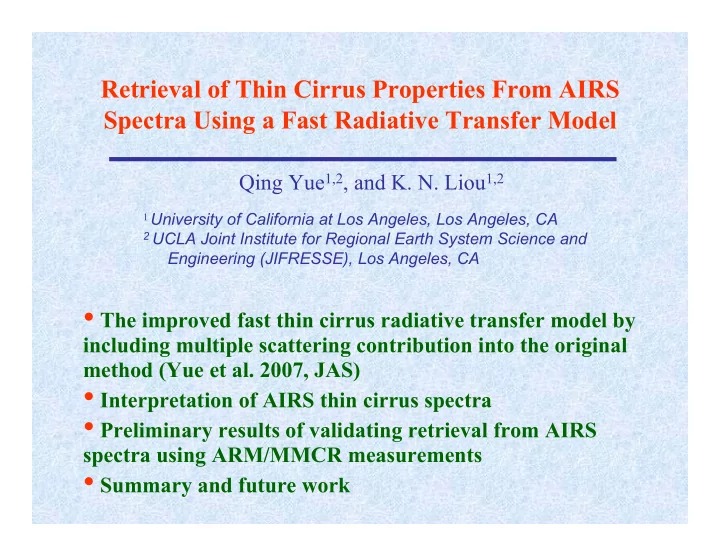

Retrieval of Thin Cirrus Properties From AIRS Spectra Using a Fast Radiative Transfer Model Qing Yue 1,2 , and K. N. Liou 1,2 1 University of California at Los Angeles, Los Angeles, CA 2 UCLA Joint Institute for Regional Earth System Science and Engineering (JIFRESSE), Los Angeles, CA • The improved fast thin cirrus radiative transfer model by including multiple scattering contribution into the original method (Yue et al. 2007, JAS) • Interpretation of AIRS thin cirrus spectra • Preliminary results of validating retrieval from AIRS spectra using ARM/MMCR measurements • Summary and future work
Why Study Thin Cirrus Clouds They are the highest clouds in the troposphere, sometimes reaching into the lower stratosphere, therefore at very cold temperature. They regularly cover 20 − 30% of the globe (Liou 1986) and have been found to have a high frequency of occurrence (e. g. Wylie et al. 2004). They are composed of non-spherical ice crystals whose sizes range from a few micrometers to thousands of micrometers. Information of the optical and microphysical properties of thin cirrus are essential to the understanding of atmospheric radiation budget and climate. Given the high location, large spatial extent, and frequent occurrence, the effect of cirrus clouds on the energy balance of the earth-atmosphere system is a critically important topic, which is strongly affected by the optical and microphysical properties of cirrus clouds..
Retrieval Method and the Improved Fast Thin Cirrus Radiative Transfer Model OPTRAN Input Files: Ice crystal SD IR database of single • Atmosphere profile and HD scattering Properties of • Surface condition models; Cirrus individual non- • Surface optical property optical depths spherical ice particles • Viewing geometry from 0.01 to 5.0 • Optical depth of gases Cloud top Bulk properties of ice cloud [D e, , • Boundary condition temperature T c ω , Q ext ,w l, l=1,…,4) Cloud IR optical depth: [ Q ]/ 2 � = � IR VIS ext IR , Single-scattering properties for combined cirrus cloud particles and gases D4S for radiative transfer in cloudy atmosphere AIRS L1B IR BT spectra χ 2 – minimization method to retrieve cloud properties
Sensitivity of Thermal Infrared BT Spectra to Optical Depth and Mean Effective Size BT spectra are sensitive to cirrus optical depth and particle size. Sensitivity to mean effective size increases as optical depth increases.
Sensitivity of Thermal Infrared BT Spectra to Optical Depth and Ice Crystal Habit Same SD and different HD are used, which generate the same De. Sensitivity to ice crystal habit.
Case Study 1: 2003.05.16.154 (Manus Island) AIRS Overpass MMCR Measured IWC (in log scale, by J. Mace) • ARM TWP Manus Island site (2.006°S, 147.425 ° E) • Pixels with cloud top temperature less than − 20°C and single layer cloud were selected: 299 pixels • ARM MMCR were operating on this date. Moderate thick cirrus clouds were observed over this site after 1500UTC. AIRS L1B Quick Browser Image
Comparison of Computed and Observed AIRS Thin Cirrus BT Spectra • Cirrus properties determined by the χ 2 -minimization method are indicated in the figure. • Computed and Observed AIRS thin cirrus BT spectra agree closely.
Analysis of Retrieved Properties of Thin Cirrus
Validation of AIRS Retrievals Using ARM MMCR Data 161 154 Pixels 154 161 MMCR 0.25 1.15 τ AIRS 0.61 1.11 MMCR 120 146 D e (µm) AIRS 91 78 Time • The mean wind speed and wind direction within the cloud layer are obtained from bloon sounding and are used to collocate MMCR time series and AIRS pixels. • Given the small wind speed, the large spatial resolution of AIRS pixel, and the short cirrus period over this site on the selected date, only two AIRS pixels were available for comparison. • MMCR retrievals are averaged over one hour.
Case Study 2: 2005.03.01.147 (Nauru Island) MMCR Reflectivity 9 10 13 AIRS Overpass Pixels 9 10 13 MMCR 0.04 0.09 0.03 τ AIRS 0.07 0.12 0.02 MMCR 63 72 57 D e (µm) AIRS 118 59 37 • Box over ARM TWP Nauru Island site (0.520°S, 166.916°E): 13 AIRS pixels • Broken cirrus were observed by MMCR. • The same collocation method has been applied to this case and three AIRS pixels were able to be collocated with ground-based data.
Summary and Future Work The fast radiative transfer model for computation of thin cirrus thermal infrared spectral radiances has been improved by incorporating the delta-four- stream (D4S) to account for the multiple scattering contributions of ice clouds. Ice crystal size and habit distribution models have been constructed. Computed brightness temperature spectra in the thermal window region show sensitivity to cirrus optical depth and ice crystal size and habit. The optical and microphysical properties of cirrus have been retrieved from AIRS measurements based on the improved fast RT model and validated by ARM MMCR data. Inter-comparison with other satellite data and ground-based measurements would be required to further validate the current retrieval method. Broadband radiative transfer calculation will be carried out to understand radiative impacts of thin cirrus and their dependence on cirrus optical and microphysical properties as well as on atmospheric conditions. Incorporate multiple layer clouds and aerosol optical properties into the current radiative transfer model.
Recommend
More recommend